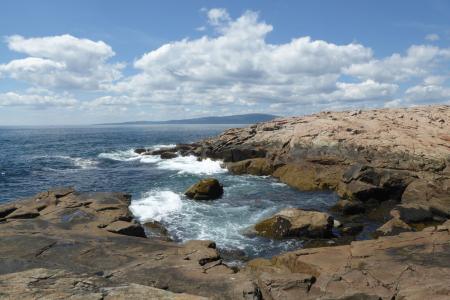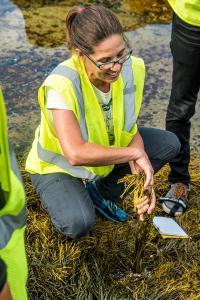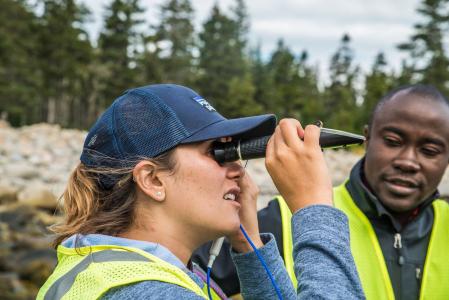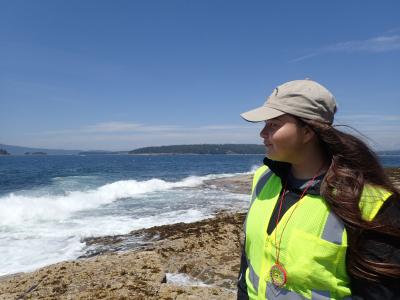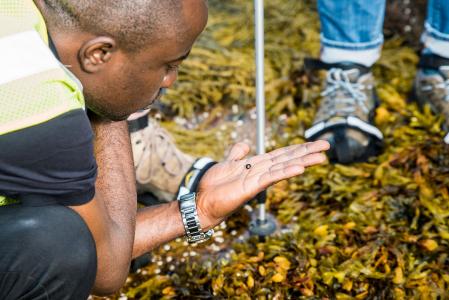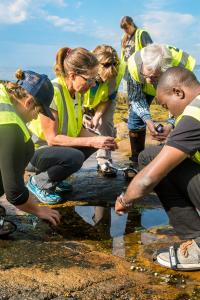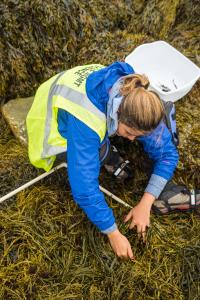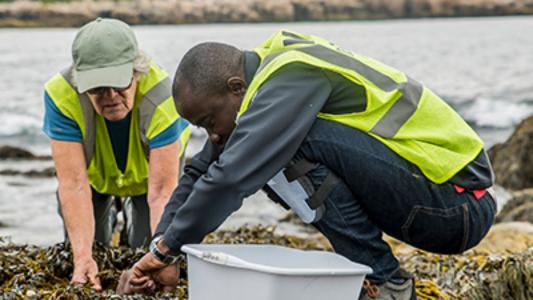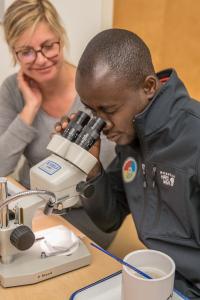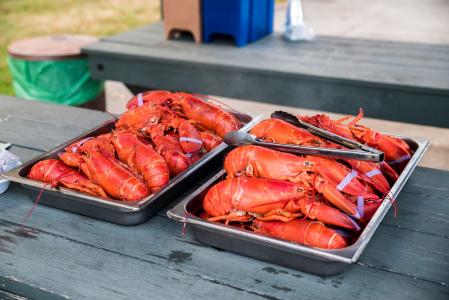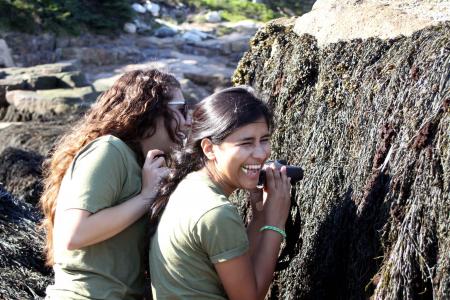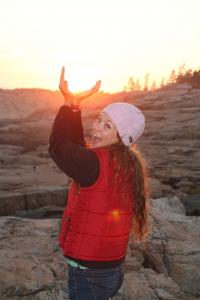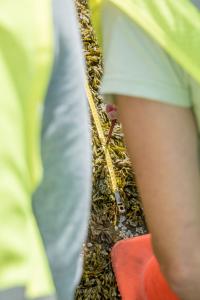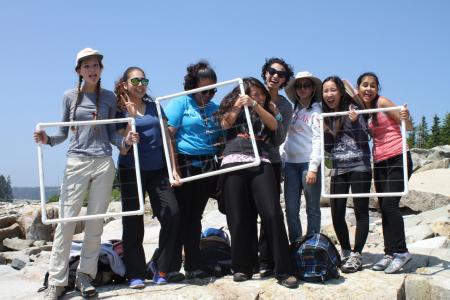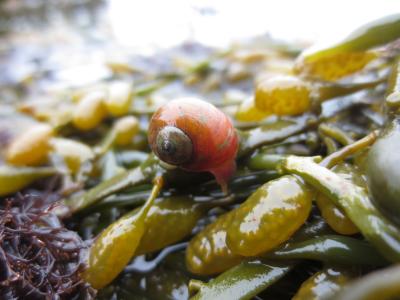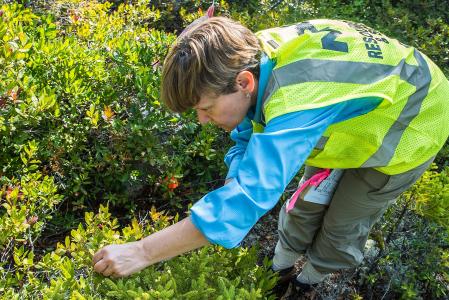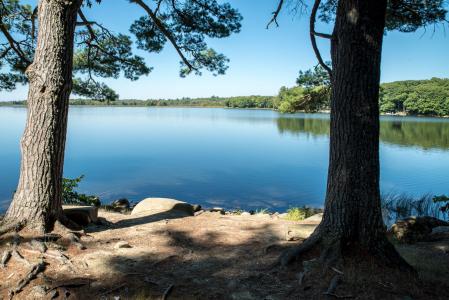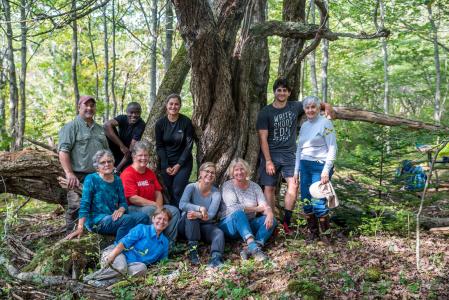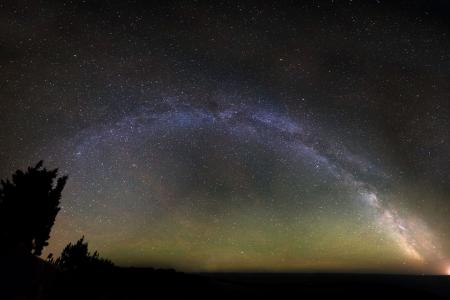Please read the following information before leaving for your expedition.
Climate Change: Sea to Trees at Acadia National Park
Expedition Briefing
Quick Navigation: COVID-19 Safety | The Research | Research Aims | How You Will Help | Life in the Field | Accommodations and Food | Project Conditions | Essential Eligibility Requirements | Health and Safety | Project Risks and Precautions | Travel Planning | Additional Resources
Click on the images to view full size!
COVID-19 Safety
You are strongly encouraged to test for COVID-19 before traveling to your expedition, particularly if you are experiencing symptoms. Do not travel if you have tested positive, and call Earthwatch right away for the next steps. Please see earthwatch.org/covid-19 for more information.
The Research
Edges are always interesting places, and Acadia National Park sits on the edge—the edge of the deciduous forest to the south and the boreal spruce-fir forest to the north. A particular edge of the sea—where a cold ocean current swooping in from the north meets warm, moist continental air. And as climate change builds, it affects all species differently—and for some on the edge, it’s creating a tipping point. The forests and intertidal zone of Acadia National Park are changing rapidly. They are anticipated to change more dramatically than most other national parks, partly because of their position at the southern boundary of boreal forests and on the coast of the rapidly changing Gulf of Maine (Pershing et al. 2015).
Managing protected areas and preserving biodiversity as climate and other environmental conditions change is a major challenge facing conservation. Most protected areas were created to protect species in place, resisting change. This approach alone is no longer viable. The US National Park Service (NPS) is shifting approaches to managing change (Colwell et al. 2012). Managers in Acadia are testing different management responses to preserve ecological integrity as conditions change. These management actions include protecting climate refugia (Smetzer and Morelli 2019), rapidly identifying and removing invasive species, restoring vegetation with species assemblages that are resilient to the changing climate, working with clam and marine worm harvesters to manage traditional harvesting in soft-bottom intertidal zones, and managing uses in different areas of the rocky intertidal zones.
This requires shifts in approaches to inventories, monitoring, and management. For example, in the past, many protected areas inventoried their floras and faunas once or repeated inventories only after very long periods (McDonough MacKenzie et al. 2019). We now know that species assemblages are changing quickly, requiring more frequent monitoring. We also know that protected areas are testing new approaches to management, including vegetation restoration projects designed to promote species assemblages adapted to changing climate conditions or protecting areas identified as climate refugia (e.g., north-facing slopes or cool springs) (Karasov-Olson et al. 2019, Morelli et al. 2016).
We are asking you to help us as we use biodiversity discovery citizen science (e.g., bioblitzes and opportunistic biodiversity observations) as a promising tool to accomplish frequent monitoring—combining targeted, seasonally repeated, small-scale bioblitzes, with more detailed citizen science monitoring of permanent sites throughout the park. This approach will help us understand how management actions affect ecological integrity in our changing park.
The Acadia region relies on its natural resources and tourism for much of its economy. These rapid ecological changes are critical for visitors and residents to acknowledge and understand so they can help preserve this iconic national park. Long-term monitoring coupled with question-driven research yields critical insights for a true understanding of the impact of these changes, which makes citizen science so important to the success of this study.
Climate Change: Sea to Trees at Acadia National Park
Research Aims
The primary aims of the project, which are critical to Acadia National Park because of their importance to the long-term management and resilience of natural resources, are to:
- Assess how ocean acidification and warming (OAW) affect the biodiversity, structure, and zonation of rocky intertidal communities (Teams 2 and 3
- Examine shifts in forest and intertidal community composition and structure in areas expected to change rapidly or sites prioritized for management actions (Teams 1, 4, 5, 6, and 7).
- Improve science literacy and environmental stewardship among participants (All teams).
INTERTIDAL—OCEAN ACIDIFICATION AND MICROPLASTICS (TEAMS 2 and 3)
Increasing carbon dioxide (CO2) levels in the atmosphere from the burning of fossil fuels is causing a decrease in ocean pH (ocean acidification) and an increase in ocean temperature (Bindoff et al. in press). The Gulf of Maine has been particularly affected by ocean acidification and warming (OAW)—it has warmed faster than 99% of the world's oceans (Pershing et al. 2015). OAW has been shown to have a negative impact on the survival and reproduction of marine organisms, especially shell-bearing, calcifying animals (Kroeker et al. 2010). OAW is also predicted to significantly affect marine biodiversity and community structure by disrupting important ecological interactions, such as predator-prey relationships and interspecific competition, and from local (and perhaps global) extinction of some species and the spread of others (Wootton et al. 2008). While the effects of ocean acidification and warming on commercially important species such as clams and oysters have been well studied in Maine, there is limited evidence available for many others, including important intertidal species, such as barnacles and snails.
The research team will aim to answer the following questions related to ocean acidification and warming (OAW):
- What is the community structure in the intertidal system and how is it changing over time in response to OAW?
- How are physical conditions of the intertidal system such as pH, temperature, and salinity, changing over time?
In addition to OAW, microplastics might also affect marine organisms and communities of Acadia National Park. Microplastics range in size from 0.3mm to 5 mm (Masura et al. 2015) and have emerged as a significant threat to marine organisms and ecosystems. Research has also shown that microplastics can be transferred among trophic levels, such as prey to predator (Farrell and Nelson 2013), which could have wide-ranging ecosystem effects. Microplastics are likely threatening the Gulf of Maine's ecologically and economically important organisms and communities. This project aims to determine whether microplastic pollution occurs off the Schoodic Peninsula and MDI and whether marine organisms are ingesting the particles.
The research team will aim to answer the following questions related to microplastics:
- Do microplastics occur in significant concentrations in the Acadia National Park region?
- What type of microplastics occur?
- Do marine organisms ingest microplastics?
BIODIVERSITY SHIFTS (TEAMS 1, 4, 5, 6, AND 7)
Acadia National Park is a hotspot for species invasions because of its heavy visitation (roughly 3.5 million visits annually) and coastal location. Additionally, species from southern locations may be shifting their ranges as climate and other conditions change. Past bioblitzes suggest dozens of species of arthropods new to the park, and Maine have arrived over the past 50 years (Chandler et al. 2012). Long-term intertidal research has shown dramatic shifts in rocky intertidal biodiversity in the Acadia National Park region (Fisher et al. 2009). Climate and vegetation models identified tree species (e.g., forest stands) that are most likely to shift in abundance as climate conditions change (Fisichelli et al. (2013).
Some areas in Acadia National Park are likely to provide climate refugia for species of conservation concern (Smetzer and Morelli 2019). These areas include forests at high elevations, north-facing slopes, and wet and coastal areas. Park managers and partners (e.g., land trusts and state agencies) are considering taking actions to protect climate refugia and to maintain ecological integrity in rapidly changing areas (e.g., by removing invasive species). Assessing changes in biodiversity in these areas will test the predictions made by climate refugia and forest change models and will directly inform management actions.
The research team will aim to answer the following questions related to biodiversity shifts in the park:
- What new species are arriving in the intertidal zone and forests of Acadia National Park?
- Is biodiversity in areas identified as climate refugia relatively stable over time relative to other areas of Acadia National Park with similar habitats?
- Are management actions benefiting target native biodiversity and promoting resilience to disturbance?
Climate Change: Sea to Trees at Acadia National Park
How You Will Help
As an Earthwatch participant, you will help inventory and monitor several field sites (forest and/or intertidal) using various sampling methods. You will assist our researchers by 1) conducting both field and lab work looking at the effects of ocean acidification and warming, and microplastics, on intertidal organisms and communities (Teams 2 and 3); 2) working in both the forest and intertidal studying community compositions, documenting birds, insects, plants, seaweed, and intertidal organisms (Teams 3, 6, 7, and 8); and 3) possibly transcribing data from historical records related to this work, as opportunity permits (all teams).
INTERTIDAL—OCEAN ACIDIFICATION AND MICROPLASTICS: FIELD AND LAB WORK (TEAMS 2 AND 3)
For ocean acidification and warming, you will sample permanent sites in the intertidal zone around the Schoodic Peninsula. This includes observing and recording species in quadrats in the middle intertidal zone and along transects from the upper to the lower intertidal to determine the species that are present, including mussels, periwinkles, barnacles, several species of seaweed, and more. These data will be added to a long-term data set to allow us to determine any changes in biodiversity, community structure, and zonation over time. You will also photograph and analyze settlement plots to determine any changes in settlement time and the survival of barnacles. Back in the lab, you will conduct experiments on the effects of ocean acidification and warming on interspecific interactions.
For microplastics, you will collect water from the intertidal zone and coastal areas. Back in the lab, you will filter the samples and then look at them under microscopes to determine the presence, size, type (i.e., fragment, microbead, film, or microfiber), and abundance of microplastics. We will also sample marine organisms, focusing on commercially and ecologically important animals, to determine how many have ingested microplastics and the types of microplastics ingested.
BIODIVERSITY SHIFTS: FIELDWORK (TEAMS 1,4, 5, 6, AND 7)
You will visit several forest and intertidal sites important to park management goals. You will inventory plants, algae, invertebrates, mammals, and birds that you can photograph using the citizen science app iNaturalist. You will also record birds readily identified by sight or sound (using eBird or Merlin apps) and signs of mammal activity (e.g., beaver activity, red squirrel middens, mink scat; using iNaturalist). You may help measure tree diameters and soil depth at forest sites to build on previous forest inventory research. You will learn to identify forest edge and intertidal zone species and some bird species that visit or inhabit this edge. You may also hunt for crabs in the intertidal, counting the number of invasive green crabs and native Jonah crabs.
HISTORICAL RECORDS
If inclement weather prevents us from going into the field, you may be involved in transcribing historical records related to the occurrence, abundance, and phenology of forest birds, insects, plants, and intertidal communities to determine if communities have changed over the last several decades. Mining through these archival records can reveal a treasure of valuable natural history observations that can provide a valuable comparative baseline with which to compare current patterns.
Climate Change: Sea to Trees at Acadia National Park
Life in the Field
Upon arrival, you’ll receive a safety briefing and a presentation on local history, conservation priorities for Acadia National Park, local examples of global issues, and a framework for all the project’s key protocols. When we begin fieldwork, project staff will introduce and demonstrate each new task. We’ll work with you until you’re comfortable with any new activities. We will also supervise to ensure data quality. You will spend your days in the forest and among tidal pools and rock benches along the beautiful Maine coast. You can explore the spectacular Schoodic Peninsula portion of Acadia National Park during your free time.
DAILY ACTIVITIES
Weather and research needs can lead to changes in the daily schedule. We appreciate your cooperation and understanding.
While there is no typical day in the field, our ‘typical’ day will be breakfast, a briefing of the work to be done that day, the safety considerations involved, and how the scientists will use the data we collect. We will follow this up by assembling our field gear, gathering our lunches, and heading into the field. We will spend most of our days in the field gathering data for our research. We may use citizen science apps like iNaturalist and other sampling methodologies to collect data on the abundance and diversity of forest plants, intertidal organisms, and birds. Some teams may work along the forest edge collecting field measurements of trees and soil depth. We will have lunch in the field and complete our fieldwork before returning to the lab to add our data to the database and prepare for the next day's fieldwork. After our fieldwork, we will listen to a pre-dinner talk from one of the scientists on the project. In the evenings, you will have time to relax and hang out, journal, take pictures, watch for moths or other evening wildlife, and stargaze.
Volunteers can submit observations of moths (and other species) drawn to the buildings' exterior lights and post them here: https://www.inaturalist.org/projects/project-porchlight. The project has over 1,500 species confirmed, with many more awaiting more rigorous species identification!
ITINERARY
DAY 1: ARRIVAL
- Arrival at Bar Harbor Airport
- Travel to Schoodic Institute
- Settle into accommodations, orientation, and team dinner
- Project introduction and safety overview
DAY 2: INTRODUCTION
- Introduction to research site and lab, research methods, and species identification training.
- Safety briefing
- Learn to use iNaturalist, eBird, and other helpful citizen science apps.
- Collect data on intertidal and/or forest biodiversity.
DAY 3–6: DATA COLLECTION
- Continue biodiversity data collection at different forest and/or intertidal sites.
- 1–2 research presentations or lectures.
DAY 7: DEPARTURE
- Departure from Schoodic Institute
Driving: If you drive yourself to the project, Earthwatch and the Schoodic Institute ask that you do not use the vehicle for personal excursions off-site during the expedition. Staying at the Schoodic Institute for the entirety of your expedition allows for deeper opportunities to connect with your team, the research discussions, and any other last-minute changes to the following day’s research tasks.
Riding in another participant’s vehicle is also at your own risk as it is not covered under the expedition’s insurance policy. Please note that a National Park Pass is needed if you plan to drive your own vehicle and park within Acadia National Park.
Climate Change: Sea to Trees at Acadia National Park
Accommodations and Food
* Please note that not every expedition has couples’ or singles’ accommodations available. Please call or email Earthwatch to check for availability prior to reserving your space(s) on the team.
Project Accommodations and Food are at the Schoodic Education and Research Center (SERC) campus in Acadia National Park. The campus is the largest National Park Service research learning center in the United States. Until 2002, the site that now houses the education and research center was a U.S. Navy base.
SLEEPING
Team members will share bedrooms in a bunkhouse or apartment on the campus. The bunkhouse is a dorm-style building with bunk beds. Each room holds 2–4 participants.
The apartment-style housing consists of two—or four-bedroom apartments with a bathroom, kitchen, and common area. Participants will have twin beds in the apartments, and all bedding is provided.
For the season running from June–September 2024:
- Teams 1, 2, 3, 4, and 6 will be in the bunkhouse.
- Teams 5 and 7 will be in 2- 4 bedroom apartments, depending on the lodging availability at the Schoodic Institute.
* Earthwatch will respectfully and without judgment honor each person’s assertion of gender identity. For both teen and adult teams, where logistics dictate single-sex accommodations or other facilities, participant placements will be made in accordance with the gender identity the participant specified on their Earthwatch Participant form and/or preferences indicated in discussions with Earthwatch.
BATHROOMS
The bunkhouse has male and female shower rooms—each with two showers and a toilet—and two individual bathrooms.
ELECTRICITY
You are welcome to bring your own electronic equipment (cell phones, digital cameras, laptops, etc.); you may be required to limit your use of laptops to recreational time only. You will be asked to use your phone for apps like iNaturalist, Nature’s Notebook, and eBird.
PERSONAL COMMUNICATIONS
The campus is equipped with Wi-Fi capability.
Please note: Earthwatch encourages volunteers to minimize outgoing calls and immerse themselves in the experience; likewise, family and friends should restrict calls to urgent messages only. Emergency communications will be prioritized.
FACILITIES AND AMENITIES
Group activities will take place at various locations on the campus, both indoors and outdoors (see map here: https://schoodicinstitute.org/contact-us/campus-map/). The bunkhouse has a common room with a small library of books and activities.
DISTANCE TO THE FIELD SITE
Most field sites will be within walking distance of the campus, up to one mile away. We will use a van for trips to field sites farther away.
FOOD AND WATER
When possible, participants will eat together outdoors with research staff and sometimes with other groups on campus. Breakfast and dinner are served in the cafeteria, and bag lunches are eaten in the field.
TYPICAL MEALS & SNACKS
The following are examples of foods you may find in the field. Variety depends on availability. We appreciate your flexibility.
- Breakfast: Eggs, pancakes, french toast, bagels, yogurt, granola and fresh fruit
- Lunch: Bag lunches: sandwich, fruit, cookie or bar, and chips
- Dinner: Baked chicken, lasagna, soup, bread, salad or seasonal vegetables, and dessert
- Beverages: Coffee, tea, tap water, soda, iced tea, and lemonade
We also highly recommend bringing extra snacks. Each type of accommodation has food storage options, a refrigerator, and a microwave.
SPECIAL DIETARY REQUIREMENTS
Please alert Earthwatch to any special dietary requirements (e.g., diabetes, lactose intolerance, nut or other food allergies, vegetarian or vegan diets) as soon as possible, and note them in the space provided on your participant forms.
This project can accommodate special diets for those requiring gluten-free, dairy-free, or vegetarian meals.
Premade, retail, vegan meals can be available at an additional cost, but they must be requested and paid for in advance.
Climate Change: Sea to Trees at Acadia National Park
Project Conditions
GENERAL CONDITIONS
Please visit wunderground.com and search your project location for weather and region-specific information.
Climate Change: Sea to Trees at Acadia National Park
Essential Eligibility Requirements
All participants must be able to:
- Enjoy being outdoors most of the day in variable weather, in the potential presence of wild animals.
- Tolerate cold temperatures and rain.
- Traverse wet, slippery, rocky, or seaweed-covered terrain and mudflats.
- Get low (generally squat, kneel, or sit) on barnacle-covered coastal rocks.
- Move through low, thick vegetation over variable terrain.
- Carry personal daily supplies such as lunch, water, and some small field equipment.
- Sit upright in a 15-passenger van for up to one and a half hours at a time.
- Follow verbal and/or visual instructions independently or with the assistance of a companion.
- Take an active role in your safety by recognizing and avoiding hazards if and when they arise (including, but not limited to, those described in Earthwatch materials and safety briefings). Always comply with project staff instructions and recommended safety measures.
- Be able to effectively communicate to the staff if you are experiencing distress or need assistance.
- Be able to get along with a variety of people from different backgrounds and ages, often in close proximity, for the duration of your team.
- Be comfortable surrounded by a language and/or culture different from yours.
Climate Change: Sea to Trees at Acadia National Park
Health and Safety
EMERGENCIES IN THE FIELD
Earthwatch has a 24-hour, 7-day-a-week emergency hotline number. Someone is always on call to respond to messages that come into our live answering service.
IMMUNIZATIONS & TRAVEL VACCINATIONS
Please be sure your routine immunizations are up to date (for example, diphtheria, pertussis, tetanus, polio, measles, mumps, rubella, and varicella) and that you have the appropriate vaccinations for your travel destination. Medical decisions are the responsibility of each volunteer and their doctor. Visit the Center for Disease Control and Prevention or the World Health Organization for guidance on immunizations.
If traveling from countries or regions where yellow fever is endemic, you must have a certificate of vaccination.
It is strongly encouraged that you stay up to date with your COVID-19 vaccinations, including receiving booster doses, as applicable.
Climate Change: Sea to Trees at Acadia National Park
Travel Planning
RENDEZVOUS LOCATION
Hancock County-Bar Harbor Airport, Trenton, ME
Specific travel planning details will be provided in your Earthwatch Expedition Logistics Document. This document can be found in your MyEarthwatch Portal once you enroll. Please do not book travel arrangements—such as flights—until the Expedition Logistics Document matching the current year has been published to your portal account.
ABOUT YOUR DESTINATION
Earthwatch strongly recommends that travelers investigate their destination before departure. Familiarity with the destination’s entry/exit requirements, visas, local laws, and customs can ensure smooth travel. The U.S. Department of State's Traveler’s Checklist and Destination Guides are helpful resources. For LGBTI travelers, the U.S. Department of State's LGBTI Travelers page contains many useful tips and links.
COUNTRY AND PROJECT ENTRY REQUIREMENTS
You are responsible for reviewing and abiding by your destination's entry/exit requirements.
Entry visa requirements differ by country of origin, layover, and destination and do change unexpectedly. For this reason, please confirm your visa requirements at the time of booking and again 90 days before travel. Please apply early for your visa (we recommend starting six months before the start of your expedition). Refunds will not be made for volunteers who cancel due to not obtaining their visa in time to meet the team at the rendezvous. You can find up-to-date visa requirements at the following website: travisa.com.
If a visa is required, participants should apply for a TOURIST visa. Please note that obtaining a visa can take weeks or even months. We strongly recommend using a visa agency to expedite and simplify the process.
Climate Change: Sea to Trees at Acadia National Park
Project Risks and Precautions
TRANSPORTATION
We will travel on public roads in a quiet area with few traffic issues, but risks inherent in road travel still apply. All participants will have a seat belt and must wear it whenever the vehicle is in motion. A roadside assistance service will be called if a vehicle breaks down.
HIKING
You will be walking along a rocky coastline and well-trod paths. Some areas are very well protected from the elements, while others are exposed. Additionally, you will be walking off-trail, sometimes in thick, low-to-waist-high vegetation or over loose rocks and seaweed. Participants must wear closed-toed shoes with a good grip to avoid slipping and long pants (not capris). We also recommend packing trekking poles (please reference the packing list), though they will not be required.
INSECTS
Biting and stinging insects and ticks are present. Participants will be briefed on how to inspect for tick bites daily. Participants with allergies should bring an Epi-Pen.
PLANTS
Participants may walk through areas with dense vegetation and poison ivy (although poison ivy is uncommon in the Schoodic Peninsula section of Acadia), so all participants should wear clothing covering their arms and legs.
PROJECT TASKS/ EQUIPMENT
Hands should always be washed after being in the field, especially before eating. Participants are encouraged to take regular breaks and to avoid overexerting themselves. Teamwork and attention to proper technique will keep you from wearing out or getting injured. Inform a staff member immediately if you are feeling tired or ill.
PERSONAL SECURITY
Acadia National Park is a generally safe region for travelers; however, valuables should not be left unattended in public areas.
SWIMMING
Swimming is not allowed in the Schoodic Peninsula section of Acadia National Park.
DISTANCE FROM MEDICAL CARE
There is generally a park ranger on duty during daytime hours who can provide first responder services. The local police, fire, and ambulance are also nearby and can respond reasonably quickly.
DISEASE
Please see below for immunization recommendations. Most diseases can be prevented with basic safety precautions. Please visit the CDC (cdc.gov) or WHO (who.int) websites for more information. Diseases present in this region of the U.S. include, but are not limited to, Lyme disease, rabies, bovine spongiform encephalopathy, pertussis, and West Nile Fever.
RISK OF COVID-19 OR OTHER RESPIRATORY ILLNESS
Earthwatch strongly encourages you to take precautions to help protect yourself and others from common viral respiratory illnesses, including COVID-19, flu, and RSV: stay up to date with your vaccinations; wash your hands frequently; take steps to improve air quality, for example, by increasing ventilation indoors or gathering outdoors; and use preventative measures to limit the spread if you are sick.
Persons with a higher risk of severe respiratory illness should consult their healthcare provider before participating.
Climate Change: Sea to Trees at Acadia National Park
Resources
ARTICLES
- In Maine, scientists see signs of climate change
- The National Academies Press. 2010. Ocean Acidification: A National Strategy to Meet the Challenges of a Changing Ocean.
- Hofmann, G.E., C.A. Blanchette, E.B. Rivest, and L. Kapsenberg. 2013. Taking the pulse of marine ecosystems: The importance of coupling long-term physical and biological observations in the context of global change biology. Oceanography 26(3):140–148.
- Early Bloomers
- State of the Birds Report 2019
- 314 Species on the Brink
- Autumn is Getting Later—Just Ask the Trees, Birds and Butterflies
BOOKS
- Walden Warming (Richard Primack)
- The Edge of the Sea (Rachel Carson)
- The Incidental Steward: Reflections on Citizen Science (Akiko Busch)
- The Homing Instinct (Bernd Heinrich)
- Marine Life of the North Atlantic: Canada to Cape May (Andrew Martinez)
- A Coastal Companion: A Year in the Gulf of Maine, from Cape Cod to Canada. (Catherine Schmitt)
- Ocean Acidification (Jean-Pierre Gattuso & Lina Hansson)
- Citizen Science for Coastal and Marine Conservation (John A. Cigliano and Heidi L. Ballard)
FIELD GUIDES and APPS
- Life Between the Tides: Marine Plants and Animals of the Northeast (Les Watling)
- The Sibley Field Guide to Birds of Eastern North America (David Sibley)
- HawkWatch International
- Merlin (app)
- Citizen Science Apps:
- Acadia National Park
PROJECT–RELATED WEBSITE
LITERATURE CITED
- Bindoff, NL, WWL Cheung, JG Kairo, J Arístegui, VA Guinder, R Hallberg, N Hilmi, N Jiao, MS Karim, L Levin, S O’Donoghue, SR Purca Cuicapusa, B Rinkevich, T Suga, A Tagliabue, and P Williamson. 2019. Changing Ocean, Marine Ecosystems, and Dependent Communities. In: IPCC Special Report on the Ocean and Cryosphere in a Changing Climate [H-O Pörtner, DC Roberts, V Masson-Delmotte, P Zhai, M Tignor, E Poloczanska, K Mintenbeck, A Alegría, M Nicolai, A Okem, J Petzold, . Rama, NM Weyer (eds.)]. In press.
- Chandler DS, D Manski, C Donahue, A Alyokhin. 2012. Biodiversity of the Schoodic Peninsula: results of the insect and arachnid bioblitzes at the schoodic district of Acadia National Park, Maine. Technical Bulletin-Maine Agricultural and Forest Experiment Station, Orono, ME.
- Colwell R, S Avery, J Berger, GE Davis, H Hamilton, T Lovejoy, S Malcom, A McMullen, M Novacek, RJ Roberts, R Tapia, G Machlis. 2012. Revisiting Leopold: resource stewardship in the national parks. National Park System Advisory Board Science Committee, Washington, DC.
- Farrell P and Nelson K. 2013. Trophic level transfer of microplastic: Mytilus edulis (L.) to Carcinus maenas (L.). Environmental Pollution 177: 1-3.
- Fisher JA, EC Rhile, H Liu, PS Petraitis. 2009. An intertidal snail shows a dramatic size increase over the past century. Proceedings of the National Academy of Sciences 106: 5209-5212.
- Fisichelli N, M Peters, L Iverson, S Matthews, C Hawkins Hoffman. 2013. Climate change and forests of the Acadia National Park region: Projected changes in habitat suitability for 83 tree species. National Park Service, Fort Collins, CO.
- Karasov-Olson, A, MW Schwartz, S Skikne, JD Olden, J Hellmann, CH Hoffman, G Schuurman, P Gonzalez, DJ Lawrence, S Allen, M Trammell, D Buttke, A Miller-Rushing, C Brigham, J Morisette. 2019. NPS ecological risk assessment of managed relocation as a climate adaptation strategy workbook. National Park Service, in press.
- Kroeker KJ, RL Kordas, RN Crim, GG Singh. 2010. Meta-analysis reveals negative yet variable effects of ocean acidification on marine organisms. Ecology Letters, 13: 1419-1434.
- Kroeker, K.J., R. L. Kordas, R. Crim, I.E. Hendriks, L. Ramajo, G. S. Singh, C.M. Duarte. 2013.Impacts of ocean acidification on marine organisms: quantifying sensitivities and interaction with warming. Global Change Biology (2013) 19, 1884–1896.
- Masura, J, et al. 2015. Laboratory methods for the analysis of microplastics in the marine environment: recommendations for quantifying synthetic particles in waters and sediments. NOAA Technical Memorandum NOS-OR&R-48.
- McDonough MacKenzie C, G Mittelhauser, AJ Miller-Rushing, RB Primack. 2019. Floristic change in New England and New York: regional patterns of plant species loss and decline. Rhodora 121: 1-36.
- Morelli TL, C Daly, SZ Dobrowski, DM Dulen, JL Ebersole, ST Jackson, JD Lundquist, CI Millar, SP Maher, WB Monahan, KR Nydick, KT Redmond, SC Sawyer, S Stock, SR Beissinger. 2016. Managing climate change refugia for climate adaptation. PLoS One 11: e0159909.
- Pershing AJ, MA Alexander, CM Hernandez, LA Kerr, A Le Bris, KE Mills, JA Nye, NR Record, HA Scannell, JD Scott, GD Sherwood, AC Thomas. 2015. Slow adaptation in the face of rapid warming leads to collapse of the Gulf of Maine cod fishery. Science 350: 809–812.
- Smetzer J, TL Morelli. 2019. Incorporating climate change refugia into climate adaptation in the Acadia National Park region. Smith College, Northampton, MA.
- Wootton JT, CA Pfister, JD Forester. 2008. Dynamic patterns and ecological impacts of declining ocean pH in a high-resolution multi-year dataset. Proceedings of the National Academy of Sciences 105: 18848–18853.
Climate Change: Sea to Trees at Acadia National Park
Sign up for the Earthwatch Newsletter
Be the first to know about new expeditions, stories from the field, and exciting Earthwatch news.
.
.
.


